All About I-Beams in Structural Steel Construction
When it comes to constructing large buildings, there is one type of installation that is a must-have, or the entire structure will not stand. This installation is known as an I-beam. Hidden away behind walls, these structural steel beams work hard to ensure everything stands, supporting the load that the building is putting on them. If you are curious to know more about I-beams, you are in the right place.
In this article, we will share more about the I-beam—how it is designed and where it is used.
The design of the I-beam
As the name implies, the I-beam looks like the letter “I” as a cross-section. They are made using two long planes known as the “flange,” with a middle section that holds the two together called the “web.” These beams are generally made out of steel, although they are also made out of other types of alloys, such as aluminum alloys and low-alloy steel. Similarly, different materials exist for various purposes. For instance, carbon steel is used in structural frameworks thanks to their strength and hardness, while an aluminum I-beam is used in applications where lighter weight is needed.
Likewise, these I-beams come in different thicknesses, widths, and lengths depending on their application. They are also classified depending on these differences, along with the material type. For example, a 10×20 beam stands for an I-beam that is ten inches in depth and can handle twenty pounds per foot. These dimensions will vary, once again, depending on their application, which is generally specified by the building contractors.
The factors of the I-beam
While an I-beam comes in different thicknesses and lengths, they all affect these four factors: deflection, bending, buckling, and vibration.
First, this structure must be thick enough to reduce and eliminate deflection, which is the beam’s vertical displacement. Second, the body of the beam should be strong enough to fight the bend. Third, the flanges should be considered to ensure that the I-beam does not buckle. Finally, the I-beam must be stiff and heavy enough to reduce any instances of vibrating action.
The use of I-beam
As mentioned, I-beams have many different uses. The most common use for these installations is as frames and support elements. They are generally used to reduce the need for any other supporting structure, as the beams in question can carry a lot of weight compared to other options, such as concrete pillars. They are also quite versatile and reliable, making it a common piece of construction material used in many construction projects.
Conclusion
At this point, you now know that an I-beam is a piece of metal that is commonly used in a construction project for support-purposes, thanks to their sheer ability to withstand stress. They are constructed with a flange and a web to create the “I” cross-section, giving it its name. Thanks to its construction, they are also cost-effective compared to other supporting solutions in today’s market, and they come in many different shapes and sizes to fit any requirements. To that end, thanks to their versatility and reliability, they are dubbed the “universal beam,” used in most if not all types of construction, from bridges to buildings.
C-Beams is a steel beam manufacturer in Charlotte, NC. We also supply innovative structural solutions and products dedicated to providing the best fabricated structural welded sections to be used in construction. If you are looking for high-end structural solutions for your construction project, get in touch with us today to see how we can help!






